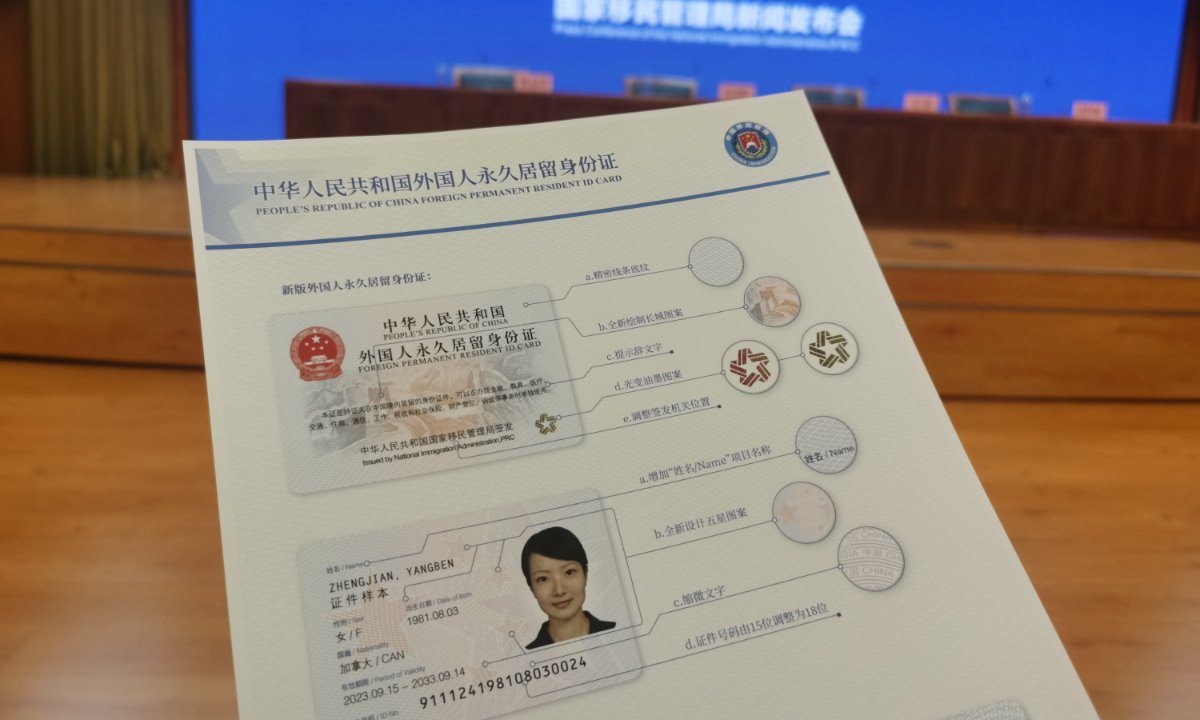The journey of China’s permanent resident card for foreigners has seen another pivotal moment in its history. A transformation is underway, changing the narrative from the colloquially known “Chinese Green Card” to the more aptly named “Five-Star Card.” This rebranding embodies the Chinese essence, marking a significant departure from the previous identity of the card.
A Deep Dive into the New Design
Launching on December 1st, as per the information received by the Global Times from a press conference, the National Immigration Administration of China is primed to release the revamped Chinese Foreign Permanent Resident ID Card. A public viewing of the card during this conference unveiled the unique Chinese touch it’s set to carry.
One can’t help but notice the intricate design of the Great Wall, symbolic of China’s strength and historical might. More intriguingly, the emblematic five stars, which represent the nation’s emblem, are now a part of this card’s identity.
Drawing parallels from naming practices around the world, experts who played a role in the card’s evolution suggest that “Five-Star Card” is not only resonant of China’s cultural fabric but also aligns with global practices of naming permanent resident cards.
The Journey from ‘Chinese Green Card’ to ‘Five-Star Card’
Historically, the card bore the informal title “Chinese Green Card.” However, sources close to the development process informed the Global Times about the necessity of a rebrand. Given the stark design differences between China’s permanent resident card and the US’s green-colored “Green Card”, it was only fitting to transition to a name that was more reflective of Chinese characteristics, hence, the “Five-Star Card.”
The nomenclature of permanent resident cards globally often mirrors the design or national symbols on the cards. America’s “Green Card” is a testament to its hue, while Canada’s “Maple Leaf Card” celebrates the nation’s iconic maple leaf.
The insider shared, “The earlier reference to China’s permanent resident card as the ‘Chinese Green Card’ was a misalignment, given that its design philosophy was miles apart from the US’ Green Card. With the fresh addition of the five-star motif, the ‘Five-Star Card’ not only emphasizes the Chinese roots but also stands out for easy identification.”
More than Just a Name: The Card’s Functionality
China’s permanent resident card isn’t merely an identification tool. Issued by the National Immigration Administration, it serves as the linchpin of identity for foreigners granted permanent residency in China. Beyond its role as a standalone identity document, it aids in various daily scenarios from housing registrations to purchasing travel tickets, eliminating the need to present foreign passports.
In the realm of technology, the “Five-Star Card” is a leap forward. It boasts state-of-the-art anti-counterfeit measures and offers enhanced storage capacities and streamlined application management services. With its impending release, cardholders will find themselves empowered, seamlessly managing a myriad of tasks, be it transport-related, financial, or daily consumption, all through online platforms.
As per insights from the Global Times, this tech-augmentation is set to further smoothen the daily life experiences, work, and studies of the cardholders within Chinese borders.
Why the Redesign? The Bigger Picture
The card’s reimagining is far from a mere aesthetic or technological upgrade. Officials from the National Immigration Administration highlight that this change is emblematic of China’s broader ambitions. It’s a strategic step, resonating with China’s endeavors to open its doors wider to the global community.
The goal is multifold. By introducing the “Five-Star Card”, there’s a clear intent to elevate the digital proficiency of services catering to foreigners, improve the efficacy and quality of immigration services, and provide a holistic experience for foreign talent flocking to China, be it for professional, educational, or residential reasons. This strategic move dovetails with China’s vision of nurturing a high-caliber workforce in the contemporary age.
What Lies Ahead
The National Immigration Administration, looking at the horizon, is gearing up for collaborations with pertinent departments. Their collective vision? To hasten the overhaul and transformation of the information infrastructures, facilities, and equipment across associated sectors. The aim is to broaden the card’s application, ensuring that user satisfaction is at its pinnacle, and the card’s functionality is realized in its entirety.
For those wondering about the fate of the current card, there’s no need for immediate change. The existing card remains valid within its stipulated timeframe. However, for those eager to transition, applications for the “Five-Star Card” will soon be open.
Conclusion
China’s “Five-Star Card” is more than a name change. It’s a reflection of evolving times, global integration, technological advances, and a nation’s commitment to showcasing its unique identity. As the curtains rise on this new chapter, it’s evident that the “Five-Star Card” is set to be a beacon of China’s journey forward.
Read More:
